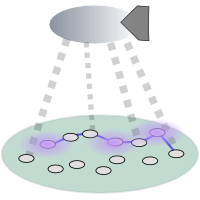Energy-Efficient Medium Access Control for Wireless Sensor Networks Realised through Aerial Platforms
Wireless sensor networks (WSNs) represent a hot research topic which has developed rapidly nowadays. In future, WSN technology will improve the quality of human life significantly with its diverse applications. But energy efficiency is commonly accepted as the key design criterion for WSNs, given the limited power supply. The purpose of this project is to investigate how an aerial platform (AP) can be applied to improve the energy efficiency of medium access control (MAC) protocol for WSNs.
This project mainly focuses on applying an aerial platform as a centralised coordinator to remove the burden of distributed scheduling, and inherently form the routes through the network. Using the radio link information which is uploaded by the sensor nodes, the AP can gather global topology information, and work out an optimal schedule for channel access and shortest path routes by using appropriate algorithms. To validate this, the feasibility of applying an AP will be examined through link budget calculations, and more accurate interference models will be designed. The benefits of better scheduling and routing will be determined by mathematical analysis. And then network simulations will be carried out to assess performance of the new protocols. A key output will be the end-to-end delay performance and energy consumption per packet, which can be compared with existing MAC protocols of WSNs.
This work will integrate closely with other sensor network research activities within the Group.
Key objectives
- To understand the implications of using aerial platform for WSNs and check the feasibility of the link budget from sensor nodes to the platform.
- To develop high energy-efficiency, low end-to-end delay, low system complexity schedule-based protocols for WSNs.
- To develop performance models which illustrate the benefits on different topologies and traffic models of sensor network.
Outputs
- Design new schedule-based MAC protocols for WSNs realised through aerial platform for different network scenarios.
- Simulations and analysis showing relative performance of the protocols.
- Contributions to conference and journal papers.

Members
- Jian Qiu
- Paul Mitchell
- David Grace
Dates
- October 2006 to
September 2010
Research
